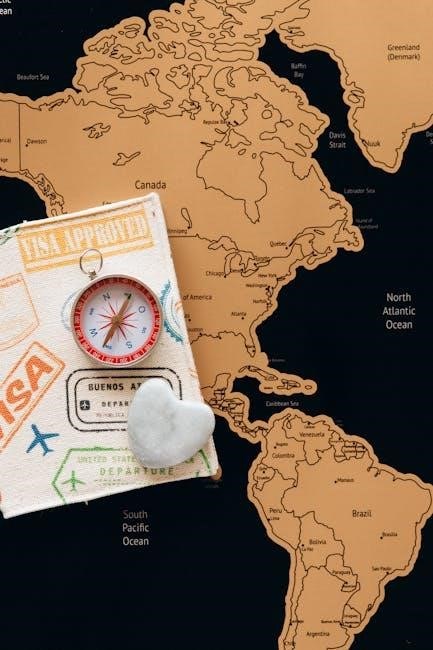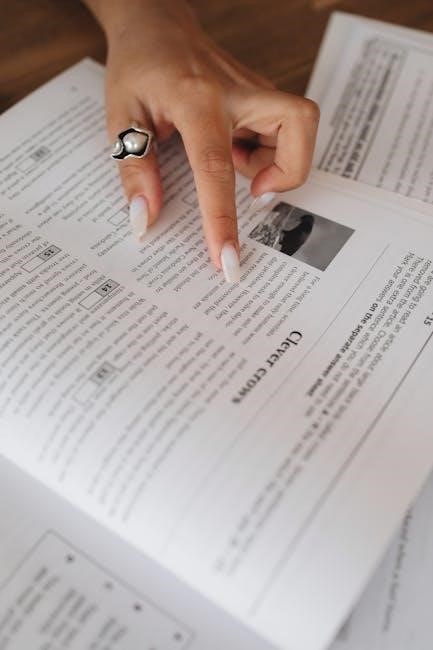
AP World History Exam Study Guide
Preparing for the AP World History exam requires a strategic approach․ Begin by understanding the exam’s structure and content․ Utilize study guides and review books like “AP World History: Modern 2020 and 2021 Study Guide․” Consider diagnostic tests to identify your strengths and weaknesses for focused studying․

Understanding the Exam Format
The AP World History exam is designed to assess your knowledge of world history from 1200 CE to the present․ It’s crucial to familiarize yourself with the exam’s structure․ The exam consists of multiple-choice questions (MCQs)‚ short-answer questions (SAQs)‚ a document-based question (DBQ)‚ and a long essay question (LEQ)․ Each section tests different skills and requires a unique approach․
The multiple-choice section evaluates your understanding of historical events‚ processes‚ and themes through source material; Short-answer questions require concise and direct responses‚ testing your ability to recall and apply historical knowledge․ The DBQ assesses your skills in analyzing and synthesizing historical documents to construct an argument‚ while the LEQ challenges you to develop and support a thesis using your broader understanding of world history․

Understanding the weighting of each section is also vital for effective preparation․ Knowing how much each part contributes to your overall score allows you to allocate your study time accordingly․ Familiarize yourself with the College Board’s official AP World History course and exam description for the most accurate and up-to-date information about the exam format․
Key Historical Periods and Themes
The AP World History exam spans several key historical periods‚ beginning around 1200 CE and continuing to the present day․ These periods are characterized by distinct developments‚ interactions‚ and transformations that have shaped the world․
Understanding the major themes that run through these periods is essential for success on the exam․ These themes include: humans and the environment; cultural developments and interactions; governance; economic systems; social interactions and organization; and technology and innovation․ These themes provide a framework for analyzing historical events and making connections across different regions and time periods․
Focus on understanding the key developments and turning points within each period․ Be able to identify the causes and consequences of major events‚ as well as the continuities and changes that occurred over time․ Pay particular attention to the interactions between different societies and the impact of these interactions on global history․ Understanding the big picture and how different events and developments are interconnected will greatly enhance your ability to answer questions effectively on the exam․
Effective Note-Taking Strategies
Effective note-taking is crucial for AP World History exam preparation․ Start by identifying key concepts and themes in your readings and lectures․ Use a structured approach‚ such as the Cornell note-taking method‚ to organize your notes effectively․
Focus on capturing the main ideas‚ supporting details‚ and connections between different topics․ Use abbreviations and symbols to save time‚ but ensure your notes remain clear and understandable․ Create visual aids like timelines and mind maps to represent complex relationships and sequences of events․
Regularly review and revise your notes to reinforce your understanding and identify any gaps in your knowledge․ Add additional information from different sources to create a comprehensive study guide․ Organize your notes chronologically or thematically to facilitate efficient retrieval and review․ Active recall‚ such as summarizing key points from memory‚ can significantly improve retention and comprehension․
Consider using digital tools like Google Docs or Evernote to create and manage your notes․ These platforms allow for easy organization‚ searchability‚ and collaboration with classmates․
Utilizing Practice Questions and Exams
Practice questions and exams are invaluable tools for AP World History preparation․ Begin by incorporating practice questions into your study routine to reinforce your understanding of key concepts and historical events․ Use a variety of question types‚ including multiple-choice‚ short answer‚ and essay questions‚ to simulate the exam experience․

Take full-length practice exams under timed conditions to assess your overall preparedness and identify areas for improvement․ Analyze your performance on each practice exam to determine your strengths and weaknesses․ Pay close attention to the types of questions you consistently struggle with and focus your review efforts accordingly․
Utilize resources like the “Cracking the AP World History Modern Exam” book by Princeton Review for additional practice materials․ Review the College Board’s website for official practice questions and sample exams․ Consider forming a study group with classmates to discuss practice questions and share insights․
Focus on understanding the reasoning behind the correct answers‚ not just memorizing them․ This will help you apply your knowledge to new and unfamiliar questions on the actual exam․ Use practice exams to improve your time management skills and develop effective test-taking strategies․

Analyzing Primary and Secondary Sources
Analyzing primary and secondary sources is a crucial skill for the AP World History exam․ Primary sources offer firsthand accounts of historical events‚ while secondary sources provide interpretations and analyses based on primary sources․ Practice identifying the author’s point of view‚ purpose‚ and intended audience in both types of sources․

When analyzing primary sources‚ consider the historical context in which they were created․ Ask yourself: What was happening at the time? Who was the author? What biases might the author have? How does this source contribute to our understanding of the past? Look for clues in the language‚ tone‚ and content of the source;
For secondary sources‚ evaluate the author’s arguments and evidence․ Is the author’s interpretation supported by the evidence? Are there alternative interpretations? How does this secondary source build upon or challenge other historical accounts? Consider the author’s credentials and potential biases․
Utilize resources that provide examples of primary and secondary source analysis․ Practice writing short essays or responses that demonstrate your ability to analyze sources effectively․ Focus on connecting the sources to broader historical themes and developments․
Mastering Essay Writing Techniques (LEQ‚ DBQ)
Mastering essay writing is crucial for success on the AP World History exam‚ particularly the Long Essay Question (LEQ) and Document-Based Question (DBQ)․ These essays require you to demonstrate your understanding of historical concepts‚ analyze evidence‚ and construct well-reasoned arguments․ Practice writing essays under timed conditions to improve your speed and accuracy․
For the LEQ‚ focus on developing a clear thesis statement that directly answers the prompt․ Provide specific historical evidence to support your argument‚ and explain how the evidence connects to your thesis․ Demonstrate an understanding of historical context and complexity․ Organize your essay logically with a clear introduction‚ body paragraphs‚ and conclusion․
The DBQ requires you to analyze and synthesize information from a set of provided documents․ Carefully read each document and identify its main idea‚ point of view‚ and potential bias․ Group the documents into categories based on common themes or arguments․ Use the documents to support your thesis‚ and explain how each document contributes to your overall argument․ Remember to cite the documents correctly․
Practice writing both LEQs and DBQs using past exam prompts․ Seek feedback from teachers or peers to identify areas for improvement․

Time Management During the Exam
Effective time management is paramount for success on the AP World History exam․ The exam is timed‚ and you need to allocate your time wisely to ensure you complete all sections․ Start by reviewing the exam structure and the time allotted for each section․
Before the exam‚ create a pacing strategy that works for you․ Determine how much time you will spend on each multiple-choice question‚ short-answer question‚ and essay․ Stick to your plan as closely as possible during the exam․ Use a timer to keep track of your progress․
During the multiple-choice section‚ don’t spend too much time on any one question․ If you are unsure of an answer‚ eliminate the obviously wrong choices and make an educated guess․ Mark the question and come back to it later if you have time․
For the essay sections‚ allocate time for planning‚ writing‚ and revising․ Start by brainstorming ideas and creating an outline․ Write a clear and concise thesis statement․ Support your arguments with specific evidence and historical context․ Proofread your essays for errors in grammar and spelling․
If you find yourself running out of time‚ prioritize the questions or essays that you know best․ Even a partial answer is better than leaving a question blank․
Reviewing Key Vocabulary and Concepts
Mastering key vocabulary and concepts is crucial for success on the AP World History exam․ The exam covers a vast range of historical topics‚ and you need to have a strong understanding of the terminology and ideas associated with each period and region․
Start by creating a list of key vocabulary terms and concepts for each time period covered on the exam․ Use your textbook‚ class notes‚ and study guides to identify the most important terms․ Define each term in your own words and provide examples of how it was used in a historical context․

Focus on understanding the relationships between different concepts․ How did the Scientific Revolution influence the Enlightenment? What were the causes and consequences of the Industrial Revolution? How did colonialism impact different parts of the world?
Use flashcards or online review tools to quiz yourself on key vocabulary and concepts․ Work with a study group to discuss and review the material․ Explain the concepts to each other and answer each other’s questions․
Pay attention to the themes that run throughout the course‚ such as the development of states‚ the interaction between humans and the environment‚ and the role of technology in shaping society․ Understanding these themes will help you make connections between different time periods and regions․
Strategies for Digital Exam Adaptation
With the increasing shift towards digital testing‚ adapting your AP World History exam strategies is crucial․ Familiarize yourself with the digital platform beforehand․ College Board offers resources and practice tests that simulate the digital exam environment․ Access these resources to understand the interface‚ tools‚ and functionalities available․
Practice typing your essays․ Speed and accuracy are essential in a digital format․ Regular typing practice can significantly improve your ability to articulate your thoughts effectively within the time constraints․ Explore keyboard shortcuts to quickly navigate the exam interface and format your responses efficiently․
Learn to manage digital resources effectively․ The digital exam may provide access to documents or other resources․ Practice using these resources efficiently to gather information and support your arguments․ Take advantage of any highlighting or annotation tools to mark important passages․

Be mindful of your posture and ergonomics to avoid fatigue during the exam․ Adjust your screen and seating position for optimal comfort․ Take short breaks to stretch and rest your eyes․

Develop a backup plan in case of technical issues; Know how to contact technical support and what steps to take if you encounter problems during the exam․ Save your work frequently to prevent data loss․
Resources for Further Study and Review
To enhance your AP World History preparation‚ leverage a variety of resources․ Start with textbooks and review books‚ such as the “AP World History: Modern 2020 and 2021 Study Guide‚” for comprehensive content coverage․ Supplement your reading with online platforms like Khan Academy‚ which offers free video lessons and practice exercises aligned with the AP curriculum․
Explore reputable websites and databases that provide primary and secondary source materials․ Engaging with these sources will deepen your understanding of historical events and perspectives․ Consider using flashcards or creating your own study guides to reinforce key concepts and vocabulary․ Utilize collaborative study groups to discuss challenging topics and share insights․
Take advantage of the College Board’s official resources‚ including past exam questions and sample responses․ Analyzing these materials will familiarize you with the exam format and scoring criteria․ Seek guidance from your teacher or tutor to address any specific areas of weakness․ Remember that consistent review and practice are essential for success on the AP World History exam․
 dsc impassa user guide
dsc impassa user guide  local tv guide pittsburgh pa
local tv guide pittsburgh pa  atc guide mode
atc guide mode  valve guide clearance
valve guide clearance  tsi math study guide pdf
tsi math study guide pdf  citi program quiz answers pdf
citi program quiz answers pdf  upper back stretches pdf
upper back stretches pdf  2023 hyundai santa fe manual
2023 hyundai santa fe manual